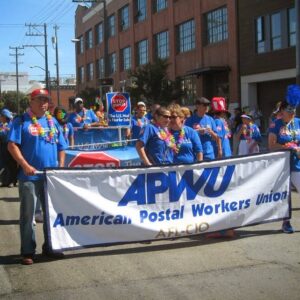November 2, 2018
Most Regressive Demands Ever
(This article first appeared in the November/December 2018 issue of the American Postal Worker magazine)
By MVS Division Director Michael O. Foster
As the parties reached the Sept. 20th contract deadline, the USPS proposals submitted at the Motor Vehicle Service (MVS) table were by far the most regressive demands in negotiations.
MVS Craft Officers expected the postal proposals would attempt to extract years of our bargaining history, achievements, and protections, but the Article 39 and 32 USPS demands went far beyond those expectations.
The Most Repressive Attempts in Bargaining
The USPS proposals would:
- Eliminate consecutive days off – “In the Motor Vehicle craft, the employees normal work week is five (5) service days, each consisting of eight (8) hours within twelve (12) hours, regardless of installation size. The five days need not be consecutive days within the service week.”
- Change Storekeeper Automotive Parts from “senior qualified” to “best qualified.”
- Eliminate frequency, time of departure, and arrival and estimate annual mileage in Article 32.2.C.1
- Article 32 A-F. The USPS proposes to notify the union after the HCR has been let.
- Change the criteria in 32.2.6 as follows: 1) Reduce round trip miles to 200. 2) Increase fixed annual rate to 200k. 3) Increase spotter value to 90k. 4) Reduce operating time to 6.5 hours.
- Article 32 exceptions, the USPS sought to exclude certain VMF repairs from 32.1: 1) Engine and transmission repair/replacement exceeding $10,000 (including parts and labor), 2) Major collision repairs, 3) Heavy duty towing/Accident repairs, 4) Frame straightening or replacement, 5) Air conditioning repair, 6) State emissions testing, and 7) Work on hybrid systems.
These USPS proposals are both regressive and repressive. As we continue to negotiate, the MVS Craft will continue to fight against the erosion of our contractual gains and benefits.
POM Finally Publishing
On August 28, the parties finally agreed on publishing parts of the Postal Operation Manual (POM) that were settled in 2007, after the union challenged changes the USPS made to the manual in 1995. The revised publication will take place within 12 weeks of the agreement. Among the provisions are:
712.1 Fleet Operations
Fleet operations encompasses local transportation operations, new vehicle requests, vehicle hire, vehicle assignment, vehicle utilization and requirements, accident investigation, dock and maneuvering area design, traffic flow, container operations and driver training.
713.1 Vehicles Used by USPS
PVS vehicles are under the jurisdiction of managers at designated offices. They are operated by USPS personnel and consist of:
- USPS-owned vehicles – vehicles purchased by the USPS.
- Hired Vehicles-vehicles hired by the USPS
- From commercial sources
- From letter carriers
714 Motor Vehicle Service
MVS is a specific category of vehicle service. It pertains only to vehicle movement of bulk quantities of mail. This is distinct from other vehicle operations, such as vehicle movement of mail by letter carriers for delivery and collection. Note:
- MVS vehicles are usually very large vehicles, some weighing more than 5 tons.
- MVS drivers are motor vehicle craft employees, rather than letter carriers, etc. (See also 721.1)
742.3 Staffing
VMF staffing is based upon planned repair work and is established only in accordance with demonstrated need. VMF staffing must
follow established guidelines by the area. (See also 715)
744.11 Scheduled Maintenance
Scheduled maintenance examinations allow deficiencies to be discovered and necessary repairs to be made when still minor in nature. This reduces the necessity for expensive, time consuming major repairs. It also reduces vehicle operations costs. Preventing a failure is less costly than correcting it after it occurs.
744.12 Repair Maintenance
Repair maintenance consists of all repair actions from malfunctions, road calls, and other abnormal breakdowns which are not corrected during scheduled maintenance examinations.The POM settlement can be found here.



